Bichop R.H. (Ed.) Mechatronic Systems, Sensors, and Actuators: Fundamentals and Modeling
Подождите немного. Документ загружается.

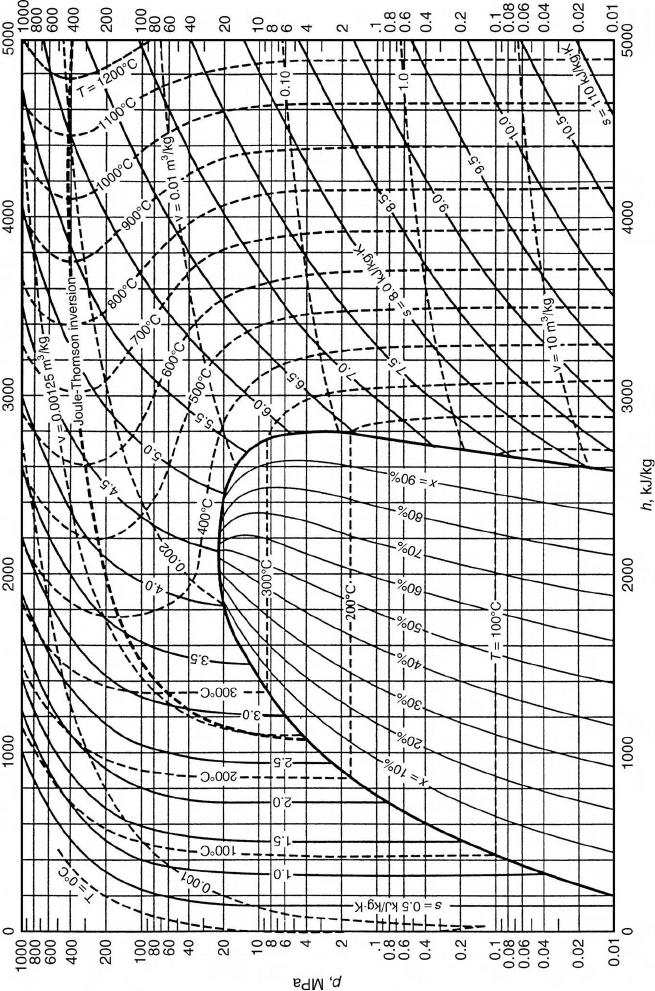
12-20 Mechatronic Systems, Sensors, and Actuators
FIGURE 12.4
Pressure–enthalpy diagram for water. (From
Jones, J.B. and Dugan, R.E. 1996.
Engineering Thermodynamics.
Prentice-Hall, Englewood
Cliffs, NJ, based on data and formulations from Haar, L., Galla
gher, J.S., and Kell, G.S. 1984.
NBS/NRC Steam Tables.
Hemisphere, Washington, D.C.)
9258_C012.fm Page 20 Thursday, October 11, 2007 3:17 PM
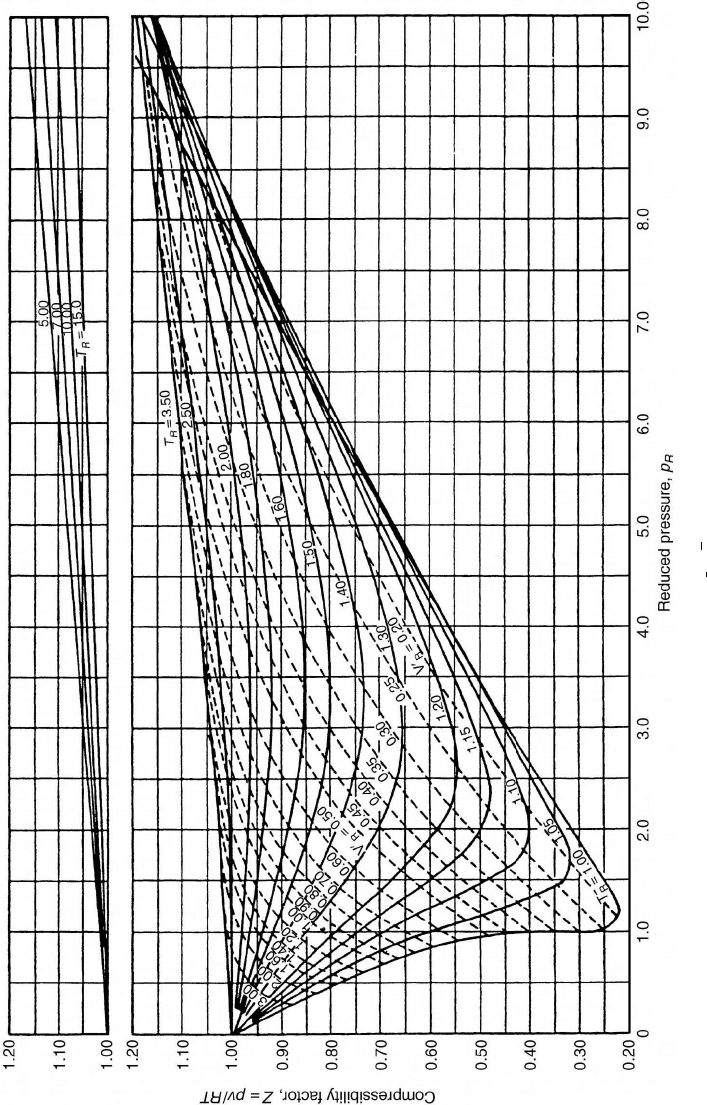
Engineering Thermodynamics 12-21
FIGURE 12.5
Generalized compressibility chart (
T
R
= T/T
c
, p
R
= p/p
c
,
) for p
R
≤ 10. (From
Obert, E.F. 1960 Concepts of Thermodynamics.
McGraw-
Hill, New York.)
v′
R
vp
c
/RT
c
=
9258_C012.fm Page 21 Thursday, October 11, 2007 3:17 PM

12-22 Mechatronic Systems, Sensors, and Actuators
It can be shown that ( )
T
vanishes identically for a gas whose equation of state is exactly given
by Equation 12.21, and thus the specific internal energy depends only on temperature. This conclusion
is supported by experimental observations beginning with the work of Joule, who showed that the internal
energy of air at low density depends primarily on temperature.
The above considerations allow for an ideal gas model of each real gas: (1) the equation of state is given
by Equations 12.21 and 12.22 the internal energy, enthalpy, and specific heats (Table 12.2) are functions
of temperature alone. The real gas approaches the model in the limit of low reduced pressure. At other
states the actual behavior may depart substantially from the predictions of the model. Accordingly, caution
should be exercised when invoking the ideal gas model lest error is introduced.
Specific heat data for gases can be obtained by direct measurement. When extrapolated to zero pressure,
ideal gas-specific heats result. Ideal gas-specific heats also can be calculated using molecular models of
matter together with data from spectroscopic measurements. The following ideal gas-specific heat rela-
tions are frequently useful:
(12.22a)
(12.22b)
where k = c
p
/c
v
.
For processes of an ideal gas between states 1 and 2, Table 12.4 gives expressions for evaluating the
changes in specific enthalpy, ∆h, specific entropy, ∆s, and specific internal energy, ∆u. Relations also are
provided for processes of an ideal gas between states having the same specific entropy: s
2
= s
1
. Property
relations and data required by the expressions of Table 12.4: h, u, c
p
, c
v
, p
r
, v
r
, and s° are obtainable from
the literature (see, e.g., Moran and Shapiro 2000).
12.4 Vapor and Gas Power Cycles
Vapor and gas power systems develop electrical or mechanical power from sources of chemical, solar, or
nuclear origin. In vapor power systems the working fluid, normally water, undergoes a phase change from
liquid to vapor, and conversely. In gas power systems, the working fluid remains a gas throughout, although
the composition normally varies owing to the introduction of a fuel and subsequent combustion.
TABLE 12.4 Ideal Gas Expressions for ∆h, ∆u, and ∆s
Variable Specific Heats Constant Specific Heats
b
(1)
(1′)
(2)
a
(2′)
(3)
(3′)
(4)
(4′)
s
2
= s
1
s
2
= s
1
(5)
(5′)
(6)
(6′)
a
Alternatively, .
b
c
p
and c
v
are average values over the temperature interval from T
1
to T
2
.
hT
2
()hT
1
()– c
p
T()Td
T
1
T
2
=
hT
2
()hT
1
()– c
p
T
2
T
1
–()=
sT
2
, p
2
()sT
1
, p
1
()–
c
p
T()
T
-------------
TR
p
2
p
1
----ln–d
T
1
T
2
=
sT
2
, p
2
()sT
1
, p
1
()– c
p
T
2
T
1
----- R
p
2
p
1
----ln–ln=
uT
2
()uT
1
()– c
v
T()Td
T
1
T
2
= uT
2
()uT
1
()– c
v
T
2
T
1
–()=
sT
2
, v
2
()sT
1
, v
1
()–
c
v
T()
T
------------
TR
v
2
v
1
----ln+d
T
1
T
2
=
sT
2
, v
2
()sT
1
, v
1
()– c
v
T
2
T
1
-----ln R
v
2
v
1
----ln+=
p
r
T
2
()
p
r
T
1
()
---- ---- --- ----
p
2
p
1
----
=
T
2
T
1
-----
p
2
p
1
----
k−1()/k
=
v
r
T
2
()
v
r
T
1
()
---- ---- --- ---
v
2
v
1
----
=
T
2
T
1
-----
v
2
v
1
----
k−1
=
sT
2
,p
2
()sT
1
,p
1
()– s° T
2
()s° T
1
()– R
p
2
p
1
----ln–=
∂
u/
∂
v
c
p
T() c
v
T() R+=
c
p
kR
k 1–
-----------
, c
v
R
k 1–
-----------
==
9258_C012.fm Page 22 Thursday, October 11, 2007 3:17 PM

Engineering Thermodynamics 12-23
The processes taking place in power systems are sufficiently complicated that idealizations are typically
employed to develop tractable thermodynamic models. The air standard analysis of gas power systems
considered in the present section is a noteworthy example. Depending on the degree of idealization, such
models may provide only qualitative information about the performance of the corresponding real-world
systems. Yet such information frequently is useful in gauging how changes in major operating parameters
might affect actual performance. Elementary thermodynamic models also can provide simple settings to
assess, at least approximately, the advantages and disadvantages of features proposed to improve ther-
modynamic performance.
12.4.1 Work and Heat Transfer in Internally Reversible Processes
Expressions giving work and heat transfer in internally reversible processes are useful in describing the
themodynamic performance of vapor and gas cycles. Important special cases are presented in the dis-
cussion to follow. For a gas as the system, the work of expansion arises from the force exerted by the
system to move the boundary against the resistance offered by the surroundings:
where the force is the product of the moving area and the pressure exerted by the system there. Noting
that Adx is the change in total volume of the system,
This expression for work applies to both actual and internal expansion processes. However, for an
internally reversible process p is not only the pressure at the moving boundary but also the pressure
throughout the system. Furthermore, for an internally reversible process the volume equals mv, where
the specific volume v has a single value throughout the system at a given instant. Accordingly, the work
of an internally reversible expansion (or compression) process per unit of system mass is
(12.23)
When such a process of a closed system is represented by a continuous curve on a plot of pressure vs.
specific volume, the area under the curve is the magnitude of the work per unit of system mass: area
a–b–c′–d′ of Figure 12.6.
For one-inlet, one-exit control volumes in the absence of internal irreversibilities, the following expres-
sion gives the work developed per unit of mass flowing:
(12.24a)
where the integral is performed from inlet to exit (see Moran and Shapiro (2000) for discussion). If there
is no significant change in kinetic or potential energy from inlet to exit, Equation 12.24a reads
(12.24b)
WFxpAxd
1
2
=d
1
2
=
WpVd
1
2
=
W
m
-----
int
rev
pvd
1
2
=
W
·
m
·
-----
int
rev
vp
v
i
2
v
e
2
–
2
---------------
gz
i
z
e
–()++d
i
e
–=
W
·
m·
-----
int
rev
vp ∆ke ∆pe 0==()d
i
e
–=
9258_C012.fm Page 23 Thursday, October 11, 2007 3:17 PM
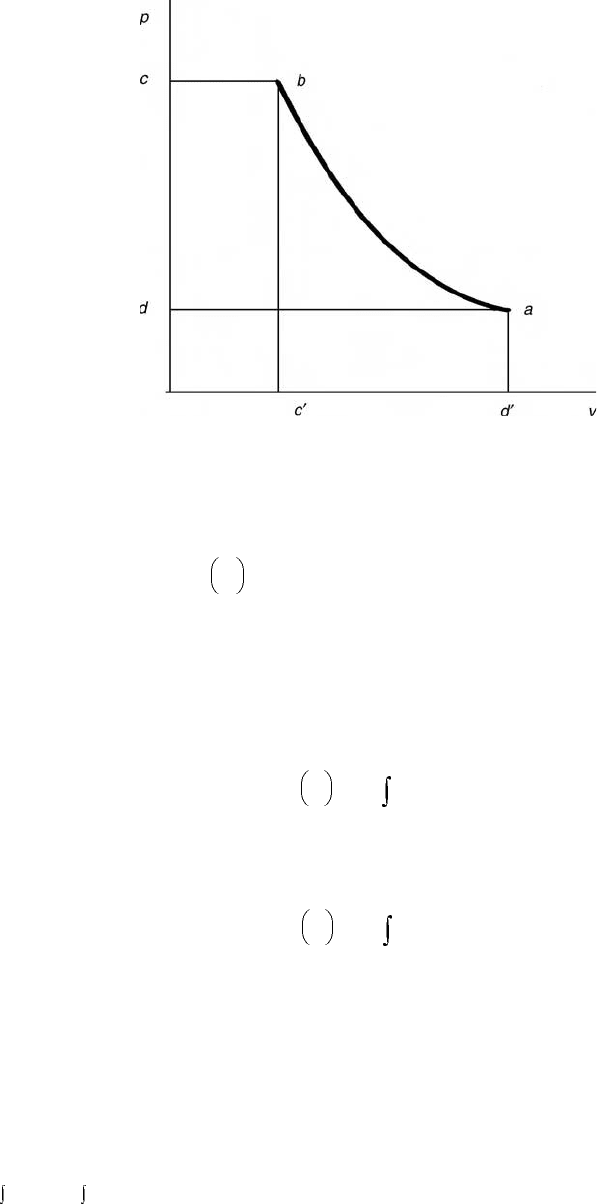
12-24 Mechatronic Systems, Sensors, and Actuators
The specific volume remains approximately constant in many applications with liquids. Then Equation
12.24b becomes
(12.24c)
When the states visited by a unit of mass flowing without irreversibilities from inlet to outlet are described
by a continuous curve on a plot pressure vs. specific volume, as shown in Figure 12.6, the magnitude of
the integral ½vdp of Equations 12.24a and b is represented by the area a–b–c–d behind the curve.
For an internally reversible process of a closed system between state 1 and state 2, the heat transfer
per unit of system mass is
(12.25)
For a one-inlet, one-exit control volume in the absence of internal irreversibilities, the following expres-
sion gives the heat transfer per unit of mass flowing from inlet i to exit e:
(12.26)
When any such process is represented by a continuous curve on a plot of temperature vs. specific entropy,
the area under the curve is the magnitude of the heat transfer per unit of mass.
12.4.1.1 Polytropic Processes
An internally reversible process described by the expression pv
n
= constant is called a polytropic process and
n is the polytropic exponent. In certain applications n can be obtained by fitting pressure-specific volume
data. Although this expression can be applied when real gases are considered, it most generally appears in
practice together with the use of the ideal gas model. Table 12.5 provides several expressions applicable to
polytropic processes and the special forms they take when the ideal gas model is assumed. The expressions
for and have application to work evaluations with Equations 12.23 and 12.24, respectively.
FIGURE 12.6 Internally reversible process on p–v coordinates.
W
·
m·
-----
int
rev
vp
e
p
i
–()v constant=()–=
Q
m
----
int
rev
Tsd
1
2
=
Q
·
m·
----
int
rev
Tsd
i
e
=
pvd vpd
9258_C012.fm Page 24 Thursday, October 11, 2007 3:17 PM
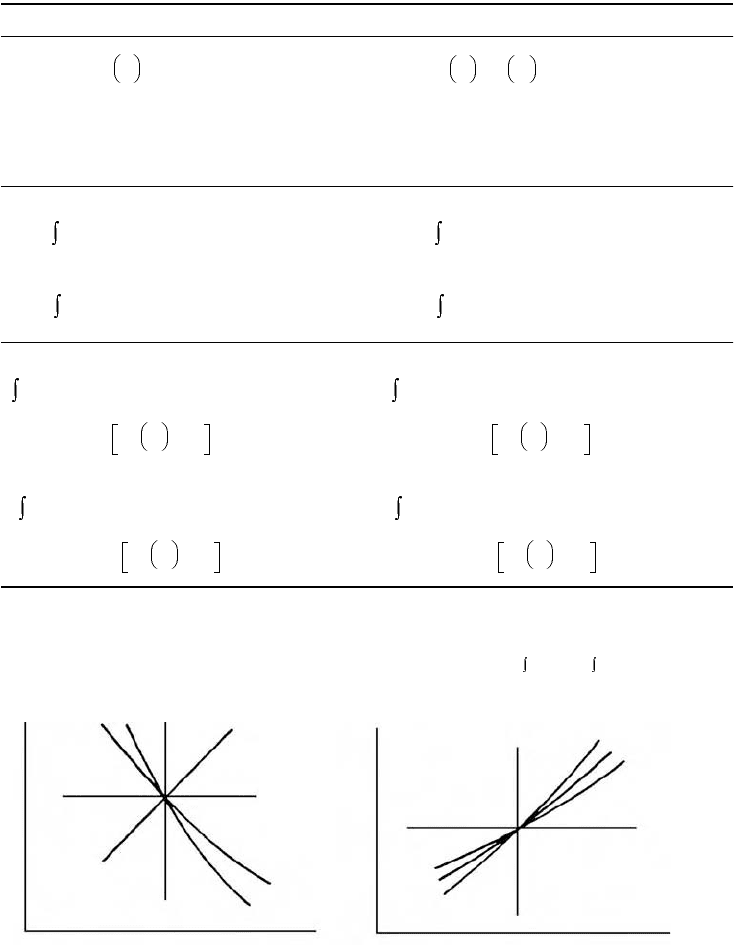
Engineering Thermodynamics 12-25
12.4.1.2 Rankine and Brayton Cycles
In their simplest embodiments vapor power and gas turbine power plants are represented conventionally
in terms of four components in series, forming, respectively, the Rankine cycle and the Brayton cycle
shown schematically in Table 12.6. The thermodynamically ideal counterparts of these cycles are com-
posed of four internally reversible processes in series: two isentropic processes alternated with two
constant pressure processes. Table 12.6 provides property diagrams of the actual and corresponding ideal
cycles. Each actual cycle is denoted 1-2-3-4-1; the ideal cycle is 1-2s-3-4s-1. For simplicity, pressure drops
through the boiler, condenser, and heat exchangers are not shown. Invoking Equation 12.26 for the ideal
cycles, the heat added per unit of mass flowing is represented by the area under the isobar from state 2s
to state 3: area a-2s-3-b-a. The heat rejected is the area under the isobar from state 4s to state 1: area
TABLE 12.5 Polytropic Processes: pv
n
= Constant
a
General Ideal Gas
b
(1) (1′)
n = 0: constant pressure
n = ±∞: constant specific volume
n = 0: constant pressure
n = ±∞: constant specific volume
n = 1: constant temperature
n = k: constant specific entropy when k is constant
n = 1 n = 1
(2) (2′)
(3) (3′)
n ≠ 1 n ≠ 1
(4) (4′)
(5) (5′)
a
For polytropic processes of closed systems where volume change is the only work mode, Equations 2, 4, and
2′, 4′ are applicable with Equation 12.23 to evaluate the work. When each unit of mass passing through a one-
inlet, one-exit control volume at steady state undergoes a polytropic process, Equations 3, 5, and 3′, 5′ are applicable
with Equations 12.24a and 12.24b to evaluate the power. Also note that generally, =
b
p
2
p
1
----
v
2
v
1
----
n
=
p
2
p
1
----
v
1
v
2
----
n
T
2
T
1
-----
n/ n−1()
==
pvd
1
2
p
1
v
1
v
2
v
1
----
ln= pvd
1
2
RT
v
2
v
1
----
ln=
vpd
1
2
p–
1
v
1
p
2
p
1
----
ln=– vpd
1
2
R– T
p
2
p
1
----
ln=–
pvd
1
2
p
2
v
2
p
1
v
1
–
1 n–
-------------------------
=
p
1
v
1
n 1–
------------
1
p
2
p
1
----
n−1()/n
–=
pvd
1
2
RT
2
T
1
–()
1 n–
--------------------------
=
RT
1
n 1–
------------
1
p
2
p
1
----
n−1()/n
–=
vpd
1
2
–
n
1 n–
------------
p
2
v
2
p
1
v
1
–()=
np
1
v
1
n 1–
-------------
1
p
2
p
1
----
n−1()/n
–=
vpd
1
2
–
nR
1 n–
------------
T
2
T
1
–()=
nRT
1
n 1–
-------------
1
p
2
p
1
----
n−1()/n
–=
1
2
vdp– n
1
2
pdv.
p
T
v
s
n = –1
n = –1
n = 1
n = 1
n = k
n = k
n = ± ∞
n = ± ∞
n = 0
n = 0
v = constant
p = constant
T = constant
s = constant
9258_C012.fm Page 25 Thursday, October 11, 2007 3:17 PM
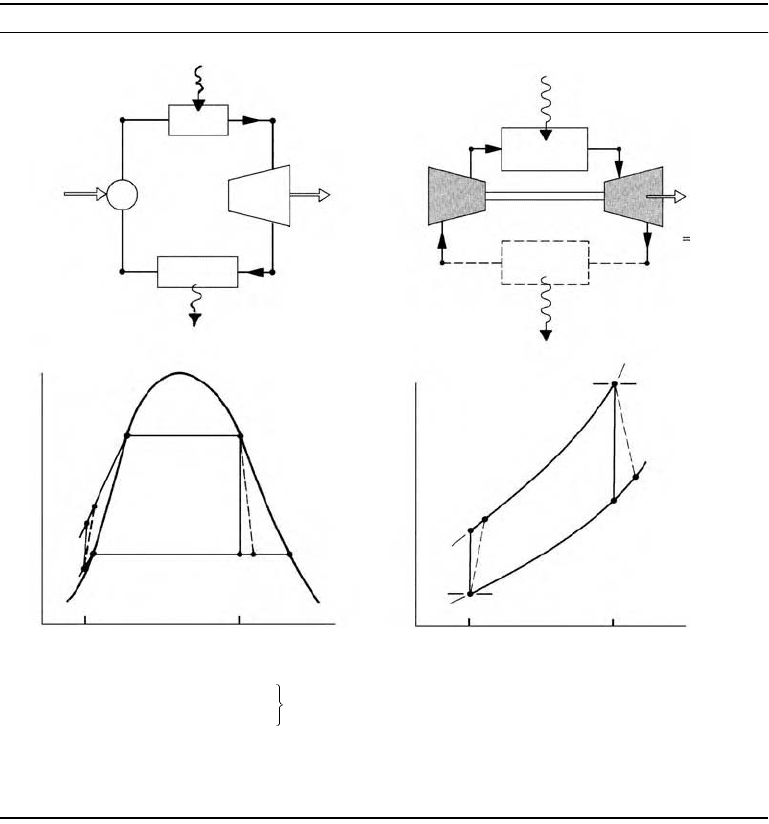
12-26 Mechatronic Systems, Sensors, and Actuators
a-1-4s-b-a. Enclosed area 1-2s-3-4s-1 represents the net heat added per unit of mass flowing. For any
power cycle, the net heat added equals the net work done.
Expressions for the principal energy transfers shown on the schematics of Table 12.6 are provided by
Equations 1 to 4 of the table. They are obtained by reducing Equation 12.10a with the assumptions of
negligible heat loss and negligible changes in kinetic and potential energy from the inlet to the exit of each
component. All quantities are positive in the directions of the arrows on the figure.
The thermal efficiency of a power cycle is defined as the ratio of the net work developed to the total
energy added by heat transfer. Using expressions (1)–(3) of Table 12.6, the thermal efficiency is
(12.27)
To obtain the thermal efficiency of the ideal cycle, h
2s
replaces h
2
and h
4s
replaces h
4
in Equation 12.27.
TABLE 12.6 Rankine and Brayton Cycles
Rankine Cycle Brayton Cycle
(>0) (1)
(>0) (2)
(>0) (3)
(>0) (4)
Q
in
Q
in
W
t
W
p
T
T
ss
Q
out
Q
out
= W
t
– W
c
W
cycle
Turbine
Turbine
Condenser
Heat exchanger
Heat exchanger
Compressor
Pump
Boiler
1
1
2
2
2
1
4
4
4s
4s
2s
2s
3
23
3
3
4
4
aabb
.
.
..
.
.
.
.
.
W
p
·
W
c
·
m
·
h
2
h
1
–()=
Q
·
in
m
·
h
3
h
2
–()=
W
·
t
m
·
h
3
h
4
–()=
Q
·
out
m
·
h
1
h
4
–()=
η
h
3
h
4
–()h
2
h
1
–()–
h
3
h
2
–
-----------------------------------------------
=
1
h
4
h
1
–
h
3
h
2
–
----------------–=
9258_C012.fm Page 26 Thursday, October 11, 2007 3:17 PM
Engineering Thermodynamics 12-27
Decisions concerning cycle operating conditions normally recognize that the thermal efficiency tends to
increase as the average temperature of heat addition increases and/or the temperature of heat rejection
decreases. In the Rankine cycle, a high average temperature of heat addition can be achieved by superheating
the vapor prior to entering the turbine and/or by operating at an elevated steam-generator pressure. In the
Brayton cycle an increase in the compressor pressure ratio p
2
/p
1
tends to increase the average temperature of
heat addition. Owing to materials limitations at elevated temperatures and pressures, the state of the working
fluid at the turbine inlet must observe practical limits, however. The turbine inlet temperature of the Brayton
cycle, for example, is controlled by providing air far in excess of what is required for combustion. In a
Rankine cycle using water as the working fluid, a low temperature of heat rejection is typically achieved
by operating the condenser at a pressure below 1 atm. To reduce erosion and wear by liquid droplets on
the blades of the Rankine cycle steam turbine, at least 90% steam quality should be maintained at the
turbine exit: x
4
> 0.9.
The back work ratio, bwr, is the ratio of the work required by the pump or compressor to the work
developed by the turbine:
(12.28)
As a relatively high specific volume vapor expands through the turbine of the Rankine cycle and a much
lower specific volume liquid is pumped, the back work ratio is characteristically quite low in vapor power
plants—in many cases on the order of 1–2%. In the Brayton cycle, however, both the turbine and compressor
handle a relatively high specific volume gas, and the back ratio is much larger, typically 40% or more.
The effect of friction and other irreversibilities for flow through turbines, compressors, and pumps is
commonly accounted for by an appropriate isentropic efficiency. Referring to Table 12.6 for the states, the
isentropic turbine efficiency is
(12.29a)
The isentropic compressor efficiency is
(12.29b)
In the isentropic pump efficiency,
, which takes the same form as Equation 12.29b, the numerator is
frequently approximated via Equation 12.24c as
h
2
s
−
h
1
≈
v
1
∆
p
, where
∆
p
is the pressure rise across the pump.
Simple gas turbine power plants differ from the Brayton cycle model in significant respects. In actual
operation, excess air is continuously drawn into the compressor, where it is compressed to a higher
pressure; then fuel is introduced and combustion occurs; finally the mixture of combustion products
and air expands through the turbine and is subsequently discharged to the surroundings. Accordingly,
the low-temperature heat exchanger shown by a dashed line in the Brayton cycle schematic of Table 12.6
is not an actual component, but included only to account formally for the cooling in the surroundings
of the hot gas discharged from the turbine.
Another frequently employed idealization used with gas turbine power plants is that of an air-standard
analysis. An air-standard analysis involves two major assumptions: (1) As shown by the Brayton cycle
schematic of Table 12.6, the temperature rise that would be brought about by combustion is effected
instead by a heat transfer from an external source. (2) The working fluid throughout the cycle is air,
which behaves as an ideal gas. In a cold air-standard analysis the specific heat ratio k for air is taken as
constant. Equations 1 to 6 of Table 12.4 apply generally to air-standard analyses. Equations 1′ to 6′
bwr
h
2
h
1
–
h
3
h
4
–
----------------
=
η
t
h
3
h
4
–
h
3
h
4s
–
-----------------
=
η
c
h
2s
h
1
–
h
2
h
1
–
-----------------
=
η
p
9258_C012.fm Page 27 Thursday, October 11, 2007 3:17 PM
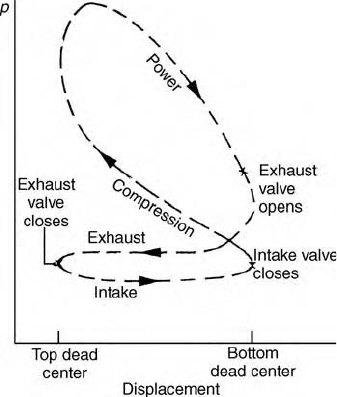
12-28 Mechatronic Systems, Sensors, and Actuators
of Table 12.4 apply to cold air-standard analyses, as does the following expression for the turbine power
obtained from Table 12.1 (Equation 10c′′):
(12.30)
An expression similar in form can be written for the power required by the compressor.
12.4.1.3 Otto, Diesel, and Dual Cycles
Although most gas turbines are also internal combustion engines, the name is usually reserved to
reciprocating internal combustion engines of the type commonly used in automobiles, trucks, and buses.
Two principal types of reciprocating internal combustion engines are the spark-ignition engine and the
compression-ignition engine. In a spark-ignition engine a mixture of fuel and air is ignited by a spark
plug. In a compression ignition engine air is compressed to a high-enough pressure and temperature that
combustion occurs spontaneously when fuel is injected.
In a four-stroke internal combustion engine, a piston executes four distinct strokes within a cylinder
for every two revolutions of the crankshaft. Figure 12.7 gives a pressure–displacement diagram as it might
be displayed electronically. With the intake valve open, the piston makes an intake stroke to draw a fresh
charge into the cylinder. Next, with both valves closed, the piston undergoes a compression stroke raising
the temperature and pressure of the charge. A combustion process is then initiated, resulting in a high-
pressure, high-temperature gas mixture. A power stroke follows the compression stroke, during which
the gas mixture expands and work is done on the piston. The piston then executes an exhaust stroke in
which the burned gases are purged from the cylinder through the open exhaust valve. Smaller engines
operate on two-stroke cycles. In two-stroke engines, the intake, compression, expansion, and exhaust
operations are accomplished in one revolution of the crankshaft. Although internal combustion engines
undergo mechanical cycles, the cylinder contents do not execute a thermodynamic cycle, since matter is
introduced with one composition and is later discharged at a different composition.
A parameter used to describe the performance of reciprocating piston engines is the mean effective
pressure, or mep. The mean effective pressure is the theoretical constant pressure that, if it acted on the
FIGURE 12.7 Pressure–displacement diagram for a reciprocating internal combustion engine.
W
·
t
m
·
kRT
3
k 1–
------------
1 p
4
/p
3
()
k 1–()/k
–[]=
9258_C012.fm Page 28 Thursday, October 11, 2007 3:17 PM

Engineering Thermodynamics 12-29
piston during the power stroke, would produce the same net work as actually developed in one cycle.
That is,
(12.31)
where the displacement volume is the volume swept out by the piston as it moves from the top dead
center to the bottom dead center. For two engines of equal displacement volume, the one with a higher
mean effective pressure would produce the greater net work and, if the engines run at the same speed,
greater power.
Detailed studies of the performance of reciprocating internal combustion engines may take into
account many features, including the combustion process occurring within the cylinder and the effects
of irreversibilities associated with friction and with pressure and temperature gradients. Heat transfer
between the gases in the cylinder and the cylinder walls and the work required to charge the cylinder
and exhaust the products of combustion also might be considered. Owing to these complexities, accurate
modeling of reciprocating internal combustion engines normally involves computer simulation.
To conduct elementary thermodynamic analyses of internal combustion engines, considerable simpli-
fication is required. A procedure that allows engines to be studied qualitatively is to employ an air-
standard analysis having the following elements: (1) a fixed amount of air modeled as an ideal gas is the
system; (2) the combustion process is replaced by a heat transfer from an external source and represented
in terms of elementary thermodynamic processes; (3) there are no exhaust and intake processes as in an
actual engine: the cycle is completed by a constant-volume heat rejection process; (4) all processes are
internally reversible.
The processes employed in air-standard analyses of internal combustion engines are selected to represent
the events taking place within the engine simply and mimic the appearance of observed pressure–displace-
ment diagrams. In addition to the constant volume heat rejection noted previously, the compression stroke
and at least a portion of the power stroke are conventionally taken as isentropic. The heat addition is
normally considered to occur at constant volume, at constant pressure, or at constant volume followed by
a constant pressure process, yielding, respectively, the Otto, Diesel, and Dual cycles shown in Table 12.7.
Reducing the closed system energy balance, Equation 12.7b, gives the following expressions for work
and heat applicable in each case shown in Table 12.7:
(12.32)
Table 12.7 provides additional expressions for work, heat transfer, and thermal efficiency identified with
each case individually. All expressions for work and heat adhere to the respective sign conventions of
Equation 12.7b. Equations 1 to 6 of Table 12.4 apply generally to air-standard analyses. In a cold air-
standard analysis the specific heat ratio k for air is taken as constant. Equations (1′) to (6′) of Table 12.4
apply to cold air-standard analyses, as does Equation 4′ of Table 12.5, with n = k for the isentropic
processes of these cycles.
Referring to Table 12.7, the ratio of specific volumes v
1
/v
2
is the compression ratio, r. For the Diesel
cycle, the ratio v
3
/v
2
is the cutoff ratio, r
c
. Figure 12.8 shows the variation of the thermal efficiency with
compression ratio for an Otto cycle and Diesel cycles having cutoff ratios of 2 and 3. The curves are
determined on a cold air-standard basis with k = 1.4 using the following expression:
(12.33)
where the Otto cycle corresponds to r
c
= 1.
mep
net work for one cycle
displacement volume
-----------------------------------------------------
=
W
12
m
---------
u
1
u
2
,
W
34
m
---------
u
3
u
4
,
Q
41
m
--------
u
1
u
4
–=–=–=
η
1
1
r
k −1
--------
r
c
k
1–
kr
c
1–()
--------------------
constant k()–=
9258_C012.fm Page 29 Thursday, October 11, 2007 3:17 PM
